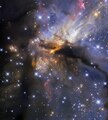Datei:Leaving on a jet (potw2340a).jpg

Größe dieser Vorschau: 541 × 599 Pixel. Weitere Auflösungen: 217 × 240 Pixel | 433 × 480 Pixel | 954 × 1.057 Pixel
Originaldatei (954 × 1.057 Pixel, Dateigröße: 431 KB, MIME-Typ: image/jpeg)
![]()
Diese Datei und die Informationen unter dem roten Trennstrich werden aus dem zentralen Medienarchiv Wikimedia Commons eingebunden.
Beschreibung
| BeschreibungLeaving on a jet (potw2340a).jpg |
English: This spectacular image shows a region called G35.2-0.7N, which is known as a hotbed of high-mass star formation. The kind of stars that form here are so massive that they will end their lives as destructive supernovae. However, even as they form they greatly impact their surroundings. At least one B-type star — the second most massive type — lurks within the region pictured here, and a powerful protostellar jet that it is launching towards us is the source of the spectacular light show. The image was taken with the Wide Field Camera 3 (WFC3), which is mounted on the NASA/ESA Hubble Space Telescope, and the region G35.2-0.7N lies around 7200 light-years from Earth in the constellation Aquila.This beautiful picture was assembled using data that were collected primarily for very specific research purposes, as are many of the Hubble Pictures of the Week. The research conducted using these data included measuring the extent of ionisation in the jets being blasted out of the protostar buried within G35.2-0.7N. Ionisation is a process by which atoms or molecules become charged, often because they are in such a high-energy environment that they have lost some of their electrons (the tiny negatively charged particles that orbit nuclei in atoms and molecules). Protostellar jets are enormous collimated beams of matter that are ejected from protostars. Collimated simply means that the matter is ejected in parallel (column-like) streams, which in turn means that the jets do not spread out much, but extend out very far in relatively straight lines.The visual result of the ejected matter is the glorious display visible in this image. Much of the nebula is dark, with light being blocked from Hubble’s view by the rich dust clouds that produce these massive stars. Near the very centre can be seen the location of the star and the jet of material it is emitting. The small, bright orange streak there is a cavity in the dust carved out by the ferocity of the jet as it streams towards us. By breaking through its dusty cocoon, the jet reveals light from the protostar, but there is still so much dust that the light is “reddened” to a fiery orange. The massive protostar lies at the very lower-left tip of this cavity.[Image Description: A nebula with stars. Dense clouds of dust and gas cover the left-hand side and a filament crosses the centre horizontally. Billowing streams of gas and dust in various colours emerge from around the centre. The very centre of the image is permeated with glowing orange regions. Many blue stars with cross-shaped spikes lie in the foreground, and small point-like stars are visible beyond the clouds.] |
| Datum | 2. Oktober 2023 (Hochladedatum) |
| Quelle | Leaving on a jet |
| Urheber | ESA/Hubble & NASA, R. Fedriani, J. Tan |
| Andere Versionen |
|
Lizenz
| ESA/Hubble images, videos and web texts are released by the ESA under the Creative Commons Attribution 4.0 International license and may on a non-exclusive basis be reproduced without fee provided they are clearly and visibly credited. Detailed conditions are below; see the ESA copyright statement for full information. For images created by NASA or on the hubblesite.org website, or for ESA/Hubble images on the esahubble.org site before 2009, use the {{PD-Hubble}} tag.
Conditions:
Notes:
|
Diese Datei ist lizenziert unter der Creative-Commons-Lizenz „Namensnennung 4.0 international“.
Namensnennung: ESA/Hubble
- Dieses Werk darf von dir
- verbreitet werden – vervielfältigt, verbreitet und öffentlich zugänglich gemacht werden
- neu zusammengestellt werden – abgewandelt und bearbeitet werden
- Zu den folgenden Bedingungen:
- Namensnennung – Du musst angemessene Urheber- und Rechteangaben machen, einen Link zur Lizenz beifügen und angeben, ob Änderungen vorgenommen wurden. Diese Angaben dürfen in jeder angemessenen Art und Weise gemacht werden, allerdings nicht so, dass der Eindruck entsteht, der Lizenzgeber unterstütze gerade dich oder deine Nutzung besonders.
Kurzbeschreibungen
Ergänze eine einzeilige Erklärung, was diese Datei darstellt.
This spectacular image shows a region called G35.2-0.7N, which is known as a hotbed of high-mass star formation. The kind of stars that form here are so massive that they will end their lives as destructive supernovae.
In dieser Datei abgebildete Objekte
Motiv
image/jpeg
1.057 Pixel
954 Pixel
441.534 Byte
fb8f529bb1ec67ec1aa556979c99718b76249155
2. Oktober 2023
pHash checksum Englisch
2j6m8s692rmh8j0l988uq8gu1rfcyfnq8ur7h6fdzt2dqb91cs
Dateiversionen
Klicke auf einen Zeitpunkt, um diese Version zu laden.
| Version vom | Vorschaubild | Maße | Benutzer | Kommentar | |
|---|---|---|---|---|---|
| aktuell | 11:00, 2. Okt. 2023 |  | 954 × 1.057 (431 KB) | OptimusPrimeBot | #Spacemedia - Upload of https://cdn.spacetelescope.org/archives/images/large/potw2340a.jpg via Commons:Spacemedia |
Dateiverwendung
Die folgende Seite verwendet diese Datei:
Metadaten
Diese Datei enthält weitere Informationen (beispielsweise Exif-Metadaten), die in der Regel von der Digitalkamera oder dem verwendeten Scanner stammen. Durch nachträgliche Bearbeitung der Originaldatei können einige Details verändert worden sein.
| Quelle | ESA/Hubble |
|---|---|
| Namensnennung/Veröffentlicher | ESA/Hubble & NASA, R. Fedriani, J. Tan |
| Kurztitel |
|
| Bildtitel |
|
| Nutzungsbedingungen |
|
| Erfassungszeitpunkt | 06:00, 2. Okt. 2023 |
| Software | Adobe Photoshop 24.4 (Windows) |
| Speicherzeitpunkt | 15:37, 20. Sep. 2023 |
| Digitalisierungszeitpunkt | 13:16, 30. Aug. 2023 |
| Datum, zu dem die Metadaten letztmalig geändert wurden | 17:37, 20. Sep. 2023 |
| Eindeutige Kennung des ursprünglichen Dokuments | xmp.did:e07931c3-d0f5-4640-a938-8a888b66ea4e |
| Kontaktinformationen |
ESA Office, Space Telescope Science Institute, 3700 San Martin Dr Baltimore, MD, 21218 United States |
| IIM-Version | 4 |


